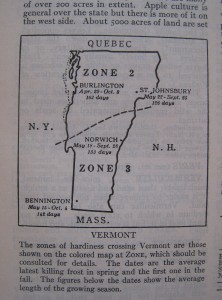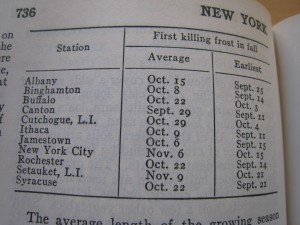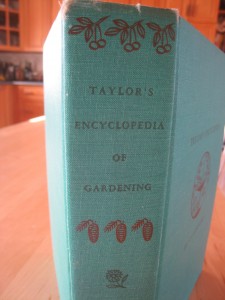Is the local growing season changing?
Like many All In readers, I like to garden and I’m fond of books.
One of the more useful books I collected shortly after moving to this region was something called “Taylor’s Encyclopedia of Gardening.” This was the 1948 edition, by Norman Taylor (1883-1967). Checking on line I discovered it’s still being produced, with a different editor, naturally.
It’s a great book, just stuffed with useful information, including small maps and charts showing the average frost-free growing season by state or province.
After 14 years of puttering around in this growing climate, here’s what I’ve noticed: it seems like every year’s been different. Cold and rainy. Hot and dry. Late spring, early spring. Once or twice it felt like we got just the right amount of sun and rain. But who can guess what to expect? Old timers, you tell me: is so much variability normal around here?
It also feels like the growing season has been getting longer. September is often a full growing month. Oh, there may be a light frost that can be dodged with sheets and blankets. But I’ve come to expect no killing frost until early Oct. Sometimes mid-October. One time it didn’t come until late October!
Here’s an article from USA Today about crops “moving” north, thanks to warmer/longer growing seasons. And something closer to home about growing-season shifts near Rochester, NY. The USDA updated their benchmark plant hardiness zone map in 2012. This New York Times article cites at least one researcher who thinks it is already outdated.

Map of typical growing seasons for Vermont, circa 1948 from Taylor’s Encyclopedia of Gardening. Photo: Lucy Martin
It’s hard to complain about gaining September as a bonus round of growing and eating. But “they say” winters are getting shorter and/or warmer, with less snow than was previously considered normal. It turns out I quite like winter. The possibility of losing that season’s many pleasures is worrisome.
Do you have a favorite reference for gardening Qs?
By now I have about 5 linear feet of books about gardening in this part of the world. For modern tips and inspiration I admire some of the books by Elliot Coleman and Barbara Damrosch. I still turn to my trusty Taylor’s, of course! In these modern times there’s also tons of stuff on line, including Cornell University Cooperative Extension.
There’s no profound point here. It’s just been another lovely, gorgeous week of warm fall weather. It made me want to ask long-time area residents about any changes in the growing season they may have noticed, good or bad.
Oct 24 postscript: A light frost returned to my back-yard garden Oct 23, followed by a hard frost the next day. We had annuals in steady bloom and could harvest green pole beans right up until those dates.
Tags: agriculture, food, gardening, growing season, Norman Taylor, plant hardiness zones, science, weather










Yes. It won’t be long before there is no growing season.
Ice cover is rapidly expanding in the Arctic.
Further climate info.
The Arctic summer ice cover was the most since 2006 and is already rapidly freezing over. And this was to be the summer when the Arctic Ocean was supposed to be ice free.
The Antarctic has the greatest sea ice cover ever recorded and now that it is spring down there, temps continue to drop to a minus 80 F at the pole.
Pete, I don’t believe that is factually true. It’s greater than 2012, but pretty similar to the previous four years.. and a lot less than the 1981-2010 average: see Figure 2 http://nsidc.org/arcticseaicenews/
I’m still picking green beans and peppers in Potsdam.
We had two really hard frosts here outside of depauville. But I had covered my gardens. We are still enjoying tomatoes, squash, carrots, brussel sprouts, egg plant and raspberries. I can’t remember my dad ever having anything in his gardens this late in the season
Before moving here we were talking with a Canton native who had relocated to our area and we asked what summers were like in the North Country. She replied that “when summer comes everyone goes out to play baseball; if it doesn’t rain that day”.
We’ve been in the area since ’74 and I have to say that the past 20-25 years or so of more moderate winters have been much easier to deal with. Winters in the late seventies (and legend has it that it was worse in the sixties) were a challenge; weeks of sub-zero temps with snow cover measured in feet from Dec-late March. I remember well heading to the woodlot one year (late 70’s, early 80’s) on an open crawler at -5 F thinking that it just wasn’t right that it was that cold; the next day was April first. I long for the summers of that era; they were also much cooler. Temps very seldom hit 80 and we never saw a ninety degree day.
My take is that, for better or worse, the weather has definitely moderated.
If you don’t believe in climate change you can go discuss it with my eggplant which is pretty reliable to still be producing in October nowadays. Even just a decade ago eggplant was hit or miss to even produce anything worthwhile at all but we would plant it on the off chance we’d get some fruit.
You need to talk with some of the real old timers. My father who is entering his 7th decade has no interest in computers but he will happily sit and tell you stories about digging tunnels through from the house to the barn when he was a boy in Colton. Winter and summer are very different from the weather he grew up with and I recognize a distinct difference from the climate here when I was young in the 1970’s.
…and now it’s the 10th of October, and I’m still picking green beans…